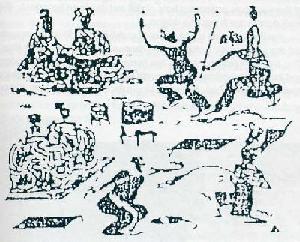|

|
| Juggling Balls and Swords at a Feat, a brick painting found in a Han tomb in Sichuan Province |
(3) Juggling. One commonplace component of Han Dynasty acrobatics was juggling, with jugglers highly proficient at using balls, swords and wheels. The most representative brick painting depicting Han juggling --Juggling Balls and Swords at a Feast-- was unearthed in Sichuan Province.
(4) Aerial stunts. Pole climbing, tightrope walking and performing on poles erected on carts are recorded in documents and depicted in pictures dating back to the Han period. Two types of pole climbing were common in Han times -- one performed on the ground and the other on a moving cart.Bai Xi Tushows a young performer somersaulting from one pole to another. The stunt is still performed in China.
(5) Horsemanship and animal acts. The earliest records of horsemanship and feats performed on horseback are found in historic Han texts and in on salt and iron, a work created by Huan Kuan during the Western Han Dynasty (206BC-8AD). A stone engravingBai Xi Tudiscovered in Yinan County, Shandong Province, provides a vivid picture of three acrobats performing feats of skill and daring on horseback. The work depicts one horse as a dragon. Han horsemen not only demonstrated skill in controlling their mounts, but also incorporated martial arts and dance movements in their routines. One particular painting depicts two horsemen -- one wielding a trident and the other brandishing a ceremonial flag. A carving found on a stone tower on Shaoshi Peak, Songshan Mountain, in Dengfen County, Henan Province, depicts two horsemen-one performing a handstand and the other a dance routine on horseback.
One Han Dynasty stone engraving found in the Temple of Confucius in Linzi, Shandong Province, depicts a group of horsemen performing stunts. It portrays a man riding a horse followed by a horse-drawn chariot. Three persons leap towards the rider from the chariot one after another, one stretches. Out his arms to reach the rider and succeeds in catching hold of his hand, another takes hold of the tail of the horse with one hand and the third is still on his flight in the air. Aside from the charioteer, all the others in the chariot are engaged in performance. Close behind the fast running chariot is a man who is making efforts to jump onto it.
All performances depicted in Han paintings and carvings provided a good foundation for the development of horsemanship and aerial stunts in later centuries.
Han brick paintings and stone engravings also depict acts performed by wild animals such as elephants, tigers, deer and snakes. Representative examples includeTaming Animals and Fighting a Snakefound in a Han tomb in Ninghai, Zhejiang Province, andSnake Charming by Boat-Peoplediscovered in the ancestral shrine of the Wu family in Jiaxiang, Shandong Province.
(6) The art of magic. The Han Dynasty marked the beginning of exchanges in the art of magic between China and the Western Regions and countries in the West. Chinese magic performances during the period can be divided into two types. The type patronized by the royal family and the nobility included performances by men disguised as legendary giant animals and required both a large number of performers and massive props.
